|
|
 |
Fiche d'espèce de Copépode |
|
|
Cyclopoida ( Ordre ) |
|
|
|
Oncaeidae ( Famille ) |
|
|
|
Triconia ( Genre ) |
|
|
| |
Triconia similis (Sars, 1918) (F,M) | |
| | | | | | | Syn.: | Oncaea similis Sars, 1918 (p.193, Descr.F, figs.F); Rose, 1933 a (p.303, figs.F); Jespersen, 1940 (p.93); Sewell, 1948 (p.393, 486); Fagetti, 1962 (p.44); Corral Estrada, 1970 (p. 224, figs.F, Rem.); ? Chen & al.,1974 (p.43, figs.F); ? Ferrari, 1975 (p.224, figs.F); Shuvalov, 1976 (in Kos, 1976, Vol. II, figs.F, Rem.); Heron, 1977 (p.47, figs.F); Dawson & Knatz, 1980 (p.9, 10, figs.F,M); Malt,1983 a (p.6, fig.F, Rem.); ? Malt & al., 1989 (p.957, Descr.M, figs.M); Böttger-Schnack, 1990 (p.869, tab.III); ? Chihara & Murano, 1997 (p.981, Pl.225: F,M); Heron & Frost, 2000 (p.1034, figs.M, tab.2, 3);
Ref. compl.: Wilson, 1942 a (p.199); 1950 (p.272); De Decker & Mombeck, 1964 (p.13); Shmeleva, 1964 a (p.1068); Mazza, 1966 (p.73); Pavlova, 1966 (p.45); Delalo, 1968 (p.139); Apostolopoulou, 1972 (p.329, 379); Vives, 1982 (p.295); Kovalev & Shmeleva, 1982 (p.86); Sazhina, 1985 a (p.491, tab.3); Greze & al., 1985 (p.8); Lozano Soldevilla & al., 1988 (p.61); Richter, 1994 (tab.4.1a); Böttger-Schnack, 1994 (p.277); Shih & Young, 1995 (p.77); Böttger-Schnack, 1996 (p.1086); 1997 (p.409); Hure & Krsinic, 1998 (p.104); Krsinic, 1998 (p.1051); Hsieh & Chiu, 1998 (tab.2); Razouls & al., 2000 (p.343, Appendix); Oncaea redacta : Heron & Bradford-Grieve, 1995 (p.29, figs.M, no F); Bollens & al., 2011 (p.1358, Table III, fig.6); Selifonova, 2011 a (p.77, Table 1, alien species in Black Sea); Lidvanov & al., 2013 (p.290, Table 2, % composition); Hwang & al., 2014 (p.43, Appendix A: seasonal abundance) | | | | Ref.: | | | Böttger-Schnack, 1999 (p.43, 44, Redescr.F,M, figs.F,M, Rem.: p.52); Krsinic & Grbec, 2002 (p.127, tab.1); Hsieh & al., 2004 (p.398, tab.1, Rem.: p.131); Nishibe & Ikeda, 2004 (p.931, Tab. 2, 4, 5); Böttger-Schnack, 2004 (p.220: tab.2, Rem.); Böttger-Schnack & Schnack, 2009 (p.131, Table 5: Rem.) ; Vives & Shmeleva, 2010 (p.349, figs.F,M, Rem.) | 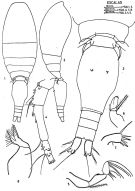 issued from : J. Corral Estrada in Tesis Doct., Univ. Madrid, A-129, Sec. Biologicas, 1970. [Lam.56]. As Oncaea similis. Female (from Canarias Is.): 1, dorsal); 2, idem (lateral right side): 3, urosome (dorsal); 4, A1; 5, A2; 6, Md; 7, Mx2. Nota: The posterior body and furca in the proportional lengths 8:54:9:7:11:11 = 100. A1: the segments in the proportional lengths 9:22:43:12:6:8 = 100
|
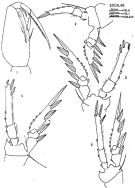 issued from : J. Corral Estrada in Tesis Doct., Univ. Madrid, A-129, Sec. Biologicas, 1970. [Lam.57]. As Oncaea similis. Female: 1, Mxp; 2, P1; 3, P2; 4, P3; 5, P4.
|
 issued from : Q.-c Chen & S.-z. Zhang & C.-s. Zhu in Studia Marina Sinica, 1974, 9. [Pl.7, Figs.14-16]. As Oncaea similis. Doubtful. Female (from China Seas): 14, habitus (dorsal); 15, Mxp; 16, P2.
|
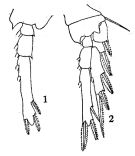 issued from : Q.-c Chen & S.-z. Zhang & C.-s. Zhu in Studia Marina Sinica, 1974, 9. [Pl.8, Figs.1-2]. As Oncaea similis. Doubtful. Female: 1, P3; 2, P4.
|
 issued from : R. Böttger-Schnack in Mitt. hamb. zool. Mus. Inst., 1999, 96 [p.46, Fig.2]; Female (from Norwegian fjord): A, habitus (dorsal); B, idem (lateral right side); C, urosome (dorsal); D, idem (lateral left side); E, A1; F, caudal ramus (dorsal, setae are numbered using Roman numerals); G, P5 (dorsal). Nota: Proportional lengths (%) of urosomites and caudal rami 9.7:56.7:5.4:5.4:11.9:10.8. Anal somite 1.4 times wider than long, about same length as caudal rami. Caudal ramus 1.9 times as long as wide. Relative lengths (%) of segments of A1 measured along posterior non-setigerous margin 7.3:23.3:42.2:10.2: 6.3:10.7.
|
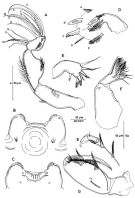 issued from : R. Böttger-Schnack in Mitt. hamb. zool. Mus. Inst., 1999, 96 [p.47, Fig.3]. Female: A, A2 (posterior, lateral elements are numbered using Roman numerals, distal elements numbered using capital letters)); B, labrum (anterior); C, idem (posterior; D, Md (showing individual elements, which are numbered using capital letters); E, Mx1; F, Mx2; G, Mxp (anterior) [g, posteror margin of Mxp basis].
|
 issued from : R. Böttger-Schnack in Mitt. hamb. zool. Mus. Inst., 1999, 96 [p.49, Fig.4]. Female: A, P1 (anterior); B, P2 (anterior); C, P3 (anterior); D, P4 (anterior, intercoxal sclerite omitted).
|
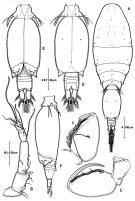 issued from : R. Böttger-Schnack in Mitt. hamb. zool. Mus. Inst., 1999, 96 [p.51, Fig.5]. Male (from Norwegian fjord): A, habitus (dorsal); B, A1; C, Mxp (posterior) [c, Mxp basis, anterior]; D, urosome (dorsal, spermatophores fully developed); E, idem (ventral); F, idem (lateral left side). Nota: Proportional lengths (%) of urosomites and caudal rami 9.4:58.3:3.8:3.4:3.8:11.6:9.8.
Relative lengths (%) of segments of A1 measured along posterior non-setigerous margin 6.3:25.1:42.4:26.2.
|
 issued from : R. Böttger-Schnack & G.A. Boxshall in J. Plankton Res., 1990, 12 (4) [p.869, Tble III]. Comparison between the females of Oncaea similis (= Triconia similis) species groups. Nota: O; similis; O. minuta; O. dentipes; O. rufa; O. umerus, O. hawii tansfered in the genus Triconia by Böttger-Schnack (1999).
|
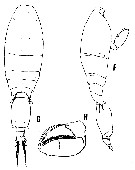 issued from : G.A. Heron & B.W. Frost in Proc. Biol. Soc. Washington, 2000, 113 (4). [p.1033, Fig.9, F-H]. As Oncaea similis. Male (from Sognoforden): F-G, lateral and dorsal, respectively; scale bar: t); H, left Mxp (scale bar: t). Scale bars: 0.1 mm, see figures 3, 4, 5, 10 of Heron and Frost, 2000 for Oncaea canadensis and Oncaea insolita. Nota: Prosome length approximately twice that of urosome. Cephalosome with posterolateral random scatter of minute refractile points associated with pores. Mxp 2nd segment expanded with anterior row of small setules; 2 setae within longitudinal cleft and inner posterior rim with 3 rows of spatulate setules of graduated lengths; terminal claw with narrow process near inner base. Swimming legs as in female. Outer basal seta longer than setae of P5.
|
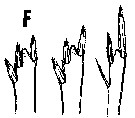 issued from : G.A. Heron & B.W. Frost in Proc. Biol. Soc. Washington, 2000, 113 (4). [p.1021, Fig.1, F]. As Oncaea similis. Female: P2-P4 endopod terminal ''spine set'' (combination of the lengths, shapes, and position of the three or two terminal spines on the endopods of swimming legs 2-4 for different Oncaea' species). Nota: P4 with terminal spine less than twice the length of subterminal spine.
|
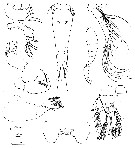 issued from : G.A. Heron in Antarct. Res. Ser. Washington, 1977, 26. [p.50, Fig.7, d-m]. As Oncaea similis. Female: d, habitus (lateral; scale bar: X); e, urosome (dorsal; lacking caudal setae; scale bar: Y); f, left A1 (scale bar: Y); g, left A2 (scale bar: Y); h, labrum (scale bar: Z); i, right Md (scale bar: Z); j, left Mx1 (scale bar: Z); k, left Mx2 (scale bar: Z); l, right Mxp (scale bar: Y); m, P1 (scale bar: Y). Nota: P5 with free segment small; 2 terminal setae, the longer spiniform and curved posteriorly; seta on body near leg. P6 probably represented by thin spiniform setule near area of external genital apparatus.
|
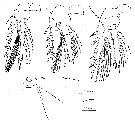 issued from : G.A. Heron in Antarct. Res. Ser. Washington, 1977, 26. [p.52, Fig.8, a-d]. As Oncaea similis. Female: a-c, P2 to P4 (scale bar: Y); d, P5 (scale bar: Z).
|
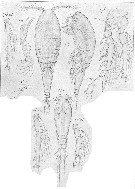 issued from : G.O. Sars in An Account of the Crustacea o Norway, 1918, VI. [Pl. CIX, 1]. as Oncaea similis. Female (from Oster Fjord, near Bergen). ri = endopoditem exp = Mx1.
| | | | | Ref. compl.: | | | Nishibe & al., 2009 (p.491, Table 1: seasonal abundance); Mazzocchi & Di Capua, 2010 (p.429); Shiganova & al., 2012 (p.61, Table 4); Uysal & Shmeleva, 2012 (p.909, Table I); in CalCOFI regional list (MDO, Nov. 2013; M. Ohman, comm. pers.); Fierro Gonzalvez, 2014 (p.1, Tab. 3, 5, occurrence, abundance); Zakaria & al., 2016 (p.1, Table 1); Benedetti & al., 2016 (p.159, Table I, fig.1, functional characters); | | | | NZ: | 17 | | |
|
Carte de distribution de Triconia similis par zones géographiques
|
| | | | | | | | | | | | | | | | | | | Loc: | | | sub-Antarct. (SW Pacif., Indian), South Africa (E), off S Cape Verde Is., Morocco-Mauritania, Canary Is., G. of Mexico, Hudson Bay, Greenland Sea, Iceland, Norway, North Sea, Medit. (Alboran Sea, W Basin, Ligurian Sea, Tyrrhenian Sea, N & S Adriatic Sea, Aegean Sea, Black Sea, W Egyptian coast, Lebanon Basin), Red Sea, Arabian Sea, Indian (SW, S, subtropical convergence), Philippines, China Seas (East China Sea, South China Sea), off SW Taiwan, Taiwan, Japan (Tosa Bay, Kuroshio & Oyashio regions), Aleutian Is., Station "P", off Washington, Washington inland, off Hawaii, E Pacif., California (San Pedro Bay & Estuary), G. of Panama, off Galapagos, off NW Easter Is., off Chile | | | | N: | 46 | | | | Lg.: | | | (109) F: 0,7-0,67; (133) F: 0,78; (679) F: 0,9-0,84; (681) M: 0,62; 0,63; (687) F: 0,65-0,62; (697) M: 0,54-0,49; (810) F: 0,80-0,72; M: 0,60-0,58; (848) F: 0,74-0,80; M: 0,58-0,68; (864) F: 0,7; (866) F: 0,68-0,59; M: 0,57-0,55; {F: 0,59-0,90; M: 0,49-0,68}
The mean female size is 0.7279 mm (n = 14; SD = 0.0875), and the mean male size is 0.0584 ( n = 10; SD = 0.0527). The size ratio (male : female) is 0.828 (n = 3; SD = 0.0582) or ± 83 %. | | | | Rem.: | mésopélagique.
Sampling depth (sub-Antarct.) : 0-500-1000 m.
Peut avoir été confondu avec d'autres formes. Certaines localisations sont douteuses.
Voir aussi les remarques en anglais | | | Dernière mise à jour : 09/12/2020 | |
|
|
 Toute utilisation de ce site pour une publication sera mentionnée avec la référence suivante : Toute utilisation de ce site pour une publication sera mentionnée avec la référence suivante :
Razouls C., Desreumaux N., Kouwenberg J. et de Bovée F., 2005-2026. - Biodiversité des Copépodes planctoniques marins (morphologie, répartition géographique et données biologiques). Sorbonne Université, CNRS. Disponible sur http://copepodes.obs-banyuls.fr [Accédé le 08 janvier 2026] © copyright 2005-2026 Sorbonne Université, CNRS
|
|
 |
 |

















